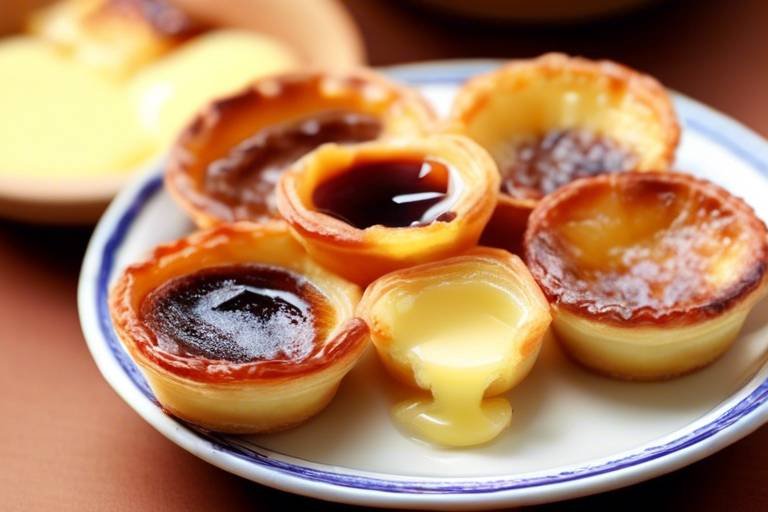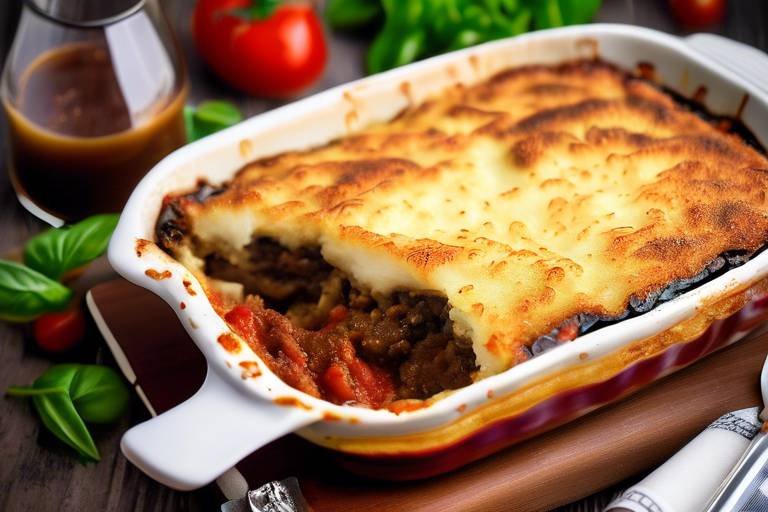The Best Portuguese Pastéis de Nata – Recipes and Tips
Are you ready to dive into the delightful world of Portuguese Pastéis de Nata? These delectable custard tarts are a true culinary treasure, loved by many for their rich history and irresistible flavors. In this article, we will explore everything you need to know about making the best Pastéis de Nata right in your own kitchen. From traditional recipes to modern twists, we’ve got you covered with expert tips and techniques to ensure your pastries turn out perfect every time.
History of Pastéis de Nata
The history of Pastéis de Nata is a tale as rich and flavorful as the pastry itself. Originating in the 18th century at the Jerónimos Monastery in Lisbon, these delectable custard tarts were created by Catholic nuns using leftover egg yolks from starched clothing. The recipe was eventually sold to a sugar refinery, which opened the first Pastéis de Belém bakery near the monastery, where the tarts became a local sensation.
Over the years, the popularity of Pastéis de Nata spread beyond Portugal, becoming a beloved treat enjoyed by people around the world. The unique combination of crispy, flaky pastry and creamy, custard filling has captured the hearts and taste buds of pastry enthusiasts everywhere, making Pastéis de Nata a symbol of Portuguese culinary tradition.
The cultural significance of Pastéis de Nata goes beyond its delicious taste. These iconic pastries are not just a dessert but a symbol of Portugal’s rich history and culinary heritage. Whether enjoyed as a morning snack with a cup of coffee or as a sweet ending to a meal, Pastéis de Nata embody the warmth and hospitality of Portuguese culture.
Ingredients for Authentic Pastéis de Nata
When it comes to creating the authentic and mouthwatering Pastéis de Nata, the key lies in selecting the finest ingredients that capture the essence of this beloved Portuguese treat. The foundation of these delectable custard tarts is a delicate balance of flavors and textures that come together to create a truly unforgettable culinary experience.
Starting with the flaky pastry crust, a combination of all-purpose flour, water, salt, and butter is essential to achieve the perfect crispy and buttery base that holds the creamy custard filling. The pastry should be rolled out thinly and carefully shaped into individual tart molds to create the iconic fluted edges that add both visual appeal and a delightful crunch to each bite.
As for the custard filling, a rich and velvety mixture of milk, sugar, egg yolks, vanilla extract, and a touch of flour is the heart of the Pastéis de Nata. The custard should be cooked gently on the stovetop until it thickens, then poured into the prepared pastry shells and baked until the top is beautifully caramelized, creating a contrast of textures and flavors that is simply irresistible.
For an extra touch of authenticity, some recipes call for a sprinkle of ground cinnamon or lemon zest on top of the custard before baking, adding a hint of warmth and brightness to the final product. These subtle yet impactful flavors elevate the Pastéis de Nata to a whole new level of indulgence, making each bite a truly decadent experience.
When sourcing ingredients for your Pastéis de Nata, opt for high-quality and fresh produce to ensure the best possible outcome. The attention to detail and the careful selection of each component will make a noticeable difference in the final result, allowing you to savor the true essence of this classic Portuguese pastry in every mouthful.
Step-by-Step Recipe Guide
Are you ready to embark on a culinary adventure and create your own batch of delicious Portuguese Pastéis de Nata? Let’s dive into the step-by-step recipe guide that will help you master this iconic dessert right in your own kitchen.
First and foremost, gather all the necessary ingredients for the pastry and custard filling. You’ll need butter, flour, sugar, salt, water, milk, egg yolks, vanilla extract, and cinnamon for that authentic Pastéis de Nata flavor.
Start by preparing the flaky pastry crust, combining flour, salt, and water to create a smooth dough. Roll out the dough thinly and spread it with butter before rolling it up into a log. Slice the log into rounds and press each round into a muffin tin to form the pastry shells.
Next, focus on the creamy custard filling that gives Pastéis de Nata their signature taste. Heat milk with sugar and cinnamon until it simmers, then slowly pour the mixture over a bowl of beaten egg yolks and flour. Stir continuously to prevent lumps and achieve a silky smooth custard consistency.
Fill each pastry shell with the custard mixture, making sure not to overfill to avoid spillage during baking. Place the Pastéis de Nata in a preheated oven and bake until the custard is set and the pastry is golden brown, creating a caramelized topping that adds a delightful crunch.
Once baked to perfection, allow the Pastéis de Nata to cool slightly before removing them from the muffin tin. Dust with powdered sugar and cinnamon for a final touch of sweetness and aroma that will elevate the flavors of this traditional Portuguese treat.
Now that you’ve followed this step-by-step guide, you’re ready to indulge in the warm, creamy goodness of freshly baked Pastéis de Nata. Share them with loved ones and savor each bite as you appreciate the time-honored tradition and craftsmanship that goes into making these delectable custard tarts.
Variations and Innovations
When it comes to Pastéis de Nata, there is a world of possibilities for creative variations and innovative twists on the classic recipe. From adding unique flavor combinations to experimenting with unconventional presentation ideas, these variations and innovations can elevate the traditional custard tart to a whole new level of culinary delight.
One popular variation is the addition of different toppings to the Pastéis de Nata. Whether it’s a sprinkling of cinnamon for a warm and spicy kick or a drizzle of chocolate for a decadent touch, these toppings can enhance the flavor profile and visual appeal of the pastry.
Another innovative approach is to play with the texture of the custard filling. By incorporating ingredients like citrus zest or nutmeg, you can add a refreshing twist or a subtle hint of spice to the creamy custard, creating a more dynamic and complex taste experience.
For those looking to push the boundaries even further, experimenting with alternative fillings can lead to exciting new flavor combinations. Imagine a Pastéis de Nata with a coconut-infused custard or a matcha green tea variation for a modern twist on this traditional treat.
Furthermore, presentation plays a crucial role in showcasing these variations and innovations. Whether it’s serving the Pastéis de Nata in individual mini tartlets or incorporating artistic swirls and patterns on the caramelized topping, creative presentation can make a visually stunning impact that enhances the overall dining experience.
Baking Tips and Techniques
When it comes to mastering the art of baking Pastéis de Nata, attention to detail is key. One crucial tip is to ensure that your pastry dough is properly chilled before rolling it out. This helps create the flaky layers that are characteristic of this delectable treat. Additionally, using high-quality butter is essential for achieving the perfect texture and flavor in the pastry.
Another important technique is to preheat your oven to the correct temperature before baking the Pastéis de Nata. This ensures that the pastry cooks evenly and the custard sets just right. Keep a close eye on the tarts while they are baking to prevent overcooking or burning, as the caramelized topping should be golden brown and slightly blistered for that authentic finish.
When preparing the custard filling, be sure to whisk the ingredients together gently to avoid incorporating too much air, which can result in a puffy and uneven texture. Straining the custard mixture before pouring it into the pastry shells helps ensure a smooth and creamy consistency without any lumps.
To achieve the signature blistered top on your Pastéis de Nata, consider using a kitchen torch to caramelize the surface after baking. This step adds a beautiful finish and enhances the flavor profile of the tarts. Allow the tarts to cool slightly before serving to let the flavors meld together for the best taste experience.
Serving and Storage Suggestions
When it comes to serving and storing Pastéis de Nata, there are a few key suggestions to keep in mind to ensure that these delectable custard tarts maintain their freshness and flavor.
First and foremost, Pastéis de Nata are best enjoyed fresh out of the oven when the pastry is still crisp and the custard is warm and creamy. To achieve this, consider baking them just before serving to capture that perfect moment of indulgence.
If you have leftover Pastéis de Nata, storing them properly is essential to preserve their quality. To store these treats, place them in an airtight container at room temperature for up to two days. Avoid refrigerating them, as this can cause the pastry to lose its crispness and the custard to become soggy.
For longer storage, Pastéis de Nata can be frozen for up to one month. To freeze them, place the tarts in a single layer in a freezer-safe container with parchment paper between each tart to prevent sticking. When ready to enjoy, simply thaw them at room temperature and reheat in a preheated oven to regain their delicious texture.
When serving Pastéis de Nata, consider dusting them with a sprinkle of powdered sugar or cinnamon for an extra touch of sweetness and flavor. Pairing these custard tarts with a hot cup of coffee or a glass of dessert wine can elevate the experience and create a delightful combination of flavors.
Pairing Pastéis de Nata with Beverages
When it comes to enjoying the delightful flavors of Pastéis de Nata, choosing the perfect beverage pairing can elevate the experience to new heights. The sweet and creamy characteristics of these Portuguese custard tarts make them a versatile treat that can be enjoyed with a variety of drinks. Whether you prefer a classic pairing or want to explore more adventurous options, there are plenty of beverages that complement the rich flavors of Pastéis de Nata.
One of the most traditional and popular choices to accompany Pastéis de Nata is a strong and aromatic Portuguese espresso. The bold flavors of the coffee provide a perfect contrast to the sweetness of the custard tart, creating a harmonious balance that delights the palate. The intensity of the espresso helps to enhance the creamy texture of the Pastéis de Nata, making each bite a truly indulgent experience.
If you’re looking for a more indulgent pairing, consider serving your Pastéis de Nata with a velvety cappuccino or latte. The frothy milk and espresso combination adds a luxurious touch to the dessert, creating a decadent treat that is perfect for special occasions or leisurely afternoon breaks. The creamy coffee complements the custard filling of the tart, creating a symphony of flavors that is sure to impress your guests.
For those who prefer non-coffee options, pairing Pastéis de Nata with dessert wines can be a delightful experience. The sweetness and complexity of fortified wines like Port or Madeira can enhance the flavors of the custard tart, creating a sophisticated pairing that is perfect for dessert lovers. The rich, nutty notes of these wines complement the buttery pastry and creamy custard, resulting in a decadent combination that is sure to please even the most discerning palates.
If you’re feeling adventurous, consider experimenting with unconventional beverage pairings to create unique taste sensations. From fruity cocktails to herbal teas, the possibilities are endless when it comes to pairing Pastéis de Nata with beverages. Let your creativity guide you as you explore different flavor combinations and discover new ways to enjoy this beloved Portuguese treat.
Sharing the Joy of Pastéis de Nata
Sharing the joy of Pastéis de Nata goes beyond just indulging in a delicious treat; it’s about creating special moments with loved ones. Imagine the warmth of a freshly baked custard tart, its delicate layers inviting you to savor each bite. Whether you’re gathered around a table with friends or sharing a quiet moment with family, Pastéis de Nata have a way of bringing people together.
These iconic Portuguese pastries are more than just food; they are a symbol of togetherness and shared experiences. The act of sharing a Pastel de Nata with someone is a gesture of care and connection, a way to show appreciation and create lasting memories. It’s about the smiles exchanged, the laughter shared, and the bonds strengthened over a simple yet exquisite dessert.
Picture a table adorned with a platter of golden-brown Pastéis de Nata, their caramelized tops glistening in the light. As you offer one to a friend or family member, you’re not just sharing a pastry; you’re sharing a piece of Portuguese culinary heritage, a taste of tradition that transcends borders and cultures.
Whether you’re hosting a gathering or simply enjoying a quiet moment at home, sharing Pastéis de Nata is a delightful experience that elevates any occasion. It’s about creating a sense of community through food, inviting others to partake in the joy that comes from savoring a perfectly crafted custard tart.
Frequently Asked Questions
- What is the origin of Pastéis de Nata?
Pastéis de Nata originated in Portugal, specifically at the Jerónimos Monastery in Lisbon. The recipe was created by Catholic monks in the 18th century and later passed on to the famous Pastéis de Belém bakery, where it became a cherished delicacy.
- What are the key ingredients in Pastéis de Nata?
The key ingredients in Pastéis de Nata include buttery puff pastry, creamy custard made from egg yolks, sugar, milk, and a hint of vanilla, as well as a sprinkle of cinnamon or powdered sugar for the finishing touch.
- How can I achieve the perfect caramelized topping on my Pastéis de Nata?
To achieve the perfect caramelized topping on your Pastéis de Nata, it’s essential to sprinkle a thin layer of sugar on top of the custard before baking. The sugar will caramelize in the oven, creating a beautiful golden brown finish that adds both flavor and visual appeal to the tarts.
Portuguese, Pastéis de Nata, Recipe, Tips, Custard tarts, Baking, Dessert, Traditional, , Portuguese, Pastéis de Nata, Recipe, Tips, Custard tarts, Baking, Dessert, Traditional,
Share this content:














Post Comment